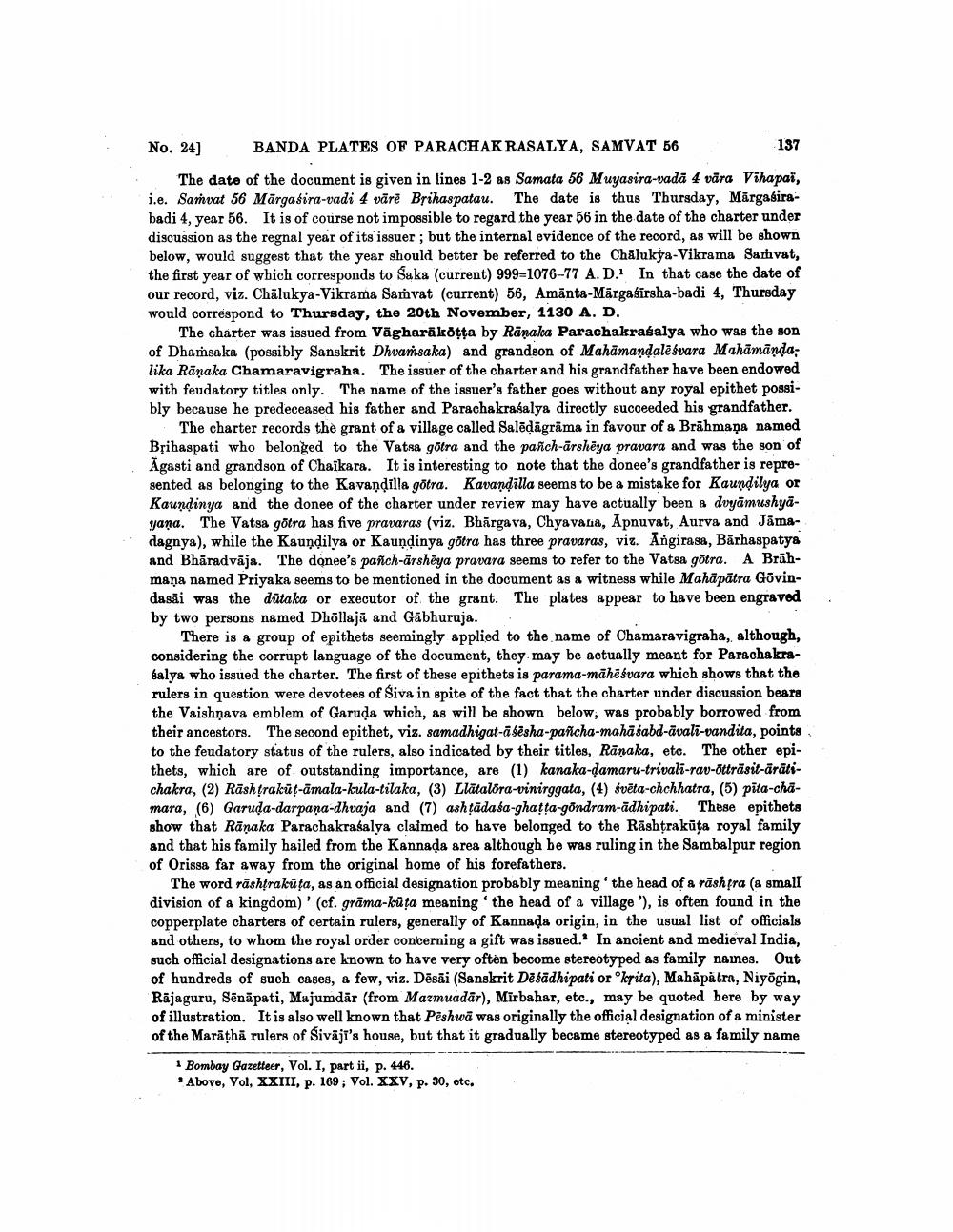________________
No. 24]
BANDA PLATES OF PARACHAKRASALYA, SAMVAT 56
The date of the document is given in lines 1-2 as Samata 56 Muyasira-vadā 4 vāra Vihapai, i.e. Samvat 56 Märgasira-vadi 4 vārē Brihaspatau. The date is thus Thursday, Margasirabadi 4, year 56. It is of course not impossible to regard the year 56 in the date of the charter under discussion as the regnal year of its issuer; but the internal evidence of the record, as will be shown below, would suggest that the year should better be referred to the Chalukya-Vikrama Samvat, the first year of which corresponds to Saka (current) 999-1076-77 A. D. In that case the date of our record, viz. Chalukya-Vikrama Samvat (current) 56, Amanta-Mārgasirsha-badi 4, Thursday would correspond to Thursday, the 20th November, 1130 A. D.
137
The charter was issued from Vagharakōṭṭa by Ranaka Parachakrasalya who was the son of Dhamsaka (possibly Sanskrit Dhvamsaka) and grandson of Mahamandalesvara Mahāmāṇḍa; lika Rāņaka Chamaravigraha. The issuer of the charter and his grandfather have been endowed with feudatory titles only. The name of the issuer's father goes without any royal epithet possibly because he predeceased his father and Parachakrasalya directly succeeded his grandfather.
The charter records the grant of a village called Saleḍāgrāma in favour of a Brāhmaṇa named Brihaspati who belonged to the Vatsa gōtra and the pañch-ārshēya pravara and was the son of Agasti and grandson of Chaikara. It is interesting to note that the donee's grandfather is represented as belonging to the Kavandilla götra. Kavandilla seems to be a mistake for Kaundilya or Kaundinya and the donee of the charter under review may have actually been a dvyāmushyāyana. The Vatsa götra has five pravaras (viz. Bhargava, Chyavana, Apnuvat, Aurva and Jamadagnya), while the Kaundilya or Kaunḍinya gotra has three pravaras, viz. Angirasa, Barhaspatya and Bharadvaja. The donee's pañch-ärsheya pravara seems to refer to the Vatsa götra. A Brāhmana named Priyaka seems to be mentioned in the document as a witness while Mahāpātra Gōvindasai was the dutaka or executor of the grant. The plates appear to have been engraved by two persons named Dhōllajā and Gabhuruja.
There is a group of epithets seemingly applied to the name of Chamaravigraha, although, considering the corrupt language of the document, they may be actually meant for Parachakrasalya who issued the charter. The first of these epithets is parama-maheśvara which shows that the rulers in question were devotees of Siva in spite of the fact that the charter under discussion bears the Vaishnava emblem of Garuda which, as will be shown below, was probably borrowed from their ancestors. The second epithet, viz. samadhigat-asēsha-pañcha-mahāśabd-āvalī-vandita, points to the feudatory status of the rulers, also indicated by their titles, Ranaka, etc. The other epithets, which are of outstanding importance, are (1) kanaka-damaru-trivalī-rav-ōtträsit-ārātichakra, (2) Rashtrakut-amala-kula-tilaka, (3) Llätalora-vinirggata, (4) śvēta-chchhatra, (5) pita-chamara, (6) Garuda-darpana-dhvaja and (7) ashṭādasa-ghaṭṭa-gōndram-adhipati. These epithets show that Rāṇaka Parachakrasalya claimed to have belonged to the Rashtrakuta royal family and that his family hailed from the Kannada area although he was ruling in the Sambalpur region of Orissa far away from the original home of his forefathers.
The word rashtrakuta, as an official designation probably meaning the head of a rashtra (a small division of a kingdom)' (cf. grāma-kūta meaning 'the head of a village'), is often found in the copperplate charters of certain rulers, generally of Kannada origin, in the usual list of officials and others, to whom the royal order concerning a gift was issued. In ancient and medieval India, such official designations are known to have very often become stereotyped as family names. Out of hundreds of such cases, a few, viz. Desai (Sanskrit Desadhipati or krita), Mahapatra, Niyōgin, Rājaguru, Sēnāpati, Majumdar (from Mazmuadar), Mirbahar, etc., may be quoted here by way of illustration. It is also well known that Peshwa was originally the official designation of a minister of the Maratha rulers of Sivaji's house, but that it gradually became stereotyped as a family name
1 Bombay Gazetteer, Vol. I, part ii, p. 446.
Above, Vol, XXIII, p. 169; Vol. XXV, p. 30, etc.




